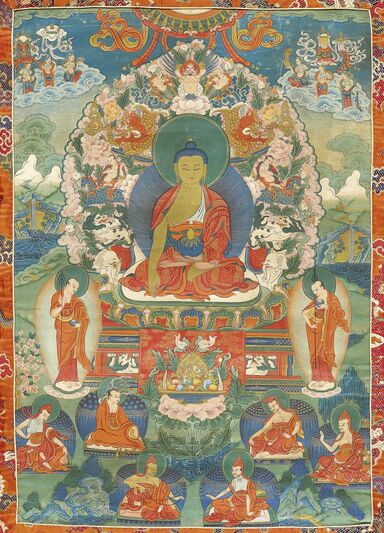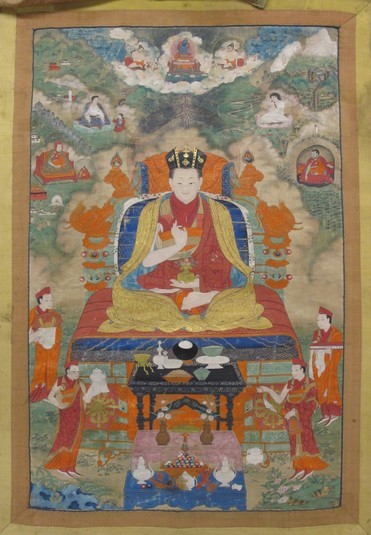Buddha Shakyamuni and the 15th Karmapa (courtesy himalyan art)
Two thousand years after me, the teaching will come to the country of the red-faced ones (i.e. Tibet) which will have been converted by Chenrezig (Skt.: Avalokiteśvara). When his teachings decline, the lion-voiced bodhisattva called Karmapa will come. He will convert beings by the power of his samādhi* and will establish them in happiness by sight, hearing, thought and touch.
Buddha Śākyamuni*
An emanation of the speech aspect of Avalokiteśvara will accomplish the benefit of beings. The first incarnation will be known as Sangchö Düsum Khyenpa. As a sign of his empowerment he wears the black crown, head ornament of his family.
Every instant of his life he will guide countless beings to enlightenment.
Padmasambhava, 8th century.**
According to Padmasambhava, Buddha Śākyamuni predicted that a former incarnation of Karmapa, Gyalwa Chokyang, would become the Buddha after the future Buddha Maitreya:
Guru Rinpoche replied: “Listen well, Sovereign. In the future, the present Gyalwa Chokyang will be known everywhere. He will introduce living beings to the fruition of the three kayas and bring them into great bliss. [As the sixth Buddha] he will have the name ‘Lion.’ As the son of the protector Maitreya, the Great Compassionate One, he will overturn the foundations of samsara.” Thus the Sugata predicted.***
*Quite often this quotation has been attributed to the Samādhirāja Sutra, but, to my knowledge, it is included in none of the commonly available versions of the sutra. Slava Ermolin (2020, email to the author) refers to Khenpo Rigzin who told him that both the Khyentse Öser’s biographie of the 15th Karmapa and, much earlier, the tertön Jatsön Nyingpo give this citation. The latter (his treasure name was Ledro Lingpa) received it as a terma. In her PhD The Life of the Sixteenth Karmapa Rangjung Rigpe Dorje: Transmitting the Dharma in Exile, Lexington Books 2022, or https://eprints.soas.ac.uk/34726/1/Wang_2020.pdf, p. 83 Meng Wang agrees with this and provides this source: Ja’ tshon snying po. rgyal dbang karma pa’i che brjod mdo rgyud lung ’dren padma’i chun po ’ja’i ming can gyis sbyar ba bzhugs so, 3.3–3.5).
In ancient India spring/summer and autumn/winter were each counted as one year, making this thousand of our years (Taranatha: History of Buddhism in India, Motilal Banarsidass 1990). Buddhism was established in Tibet under Songtsen Gampo, who ruled the country from 617-649 AD. “When his teachings decline” refers to the 10th century, when during the reign of King Langdarma Buddhism was close to extinction in the country. After this, the so-called “second wave of transmission” of the new schools revitalized the Dharma. “Lion’s Roar” (Tib.: seng ge dra, Skt.: Simhanadha) refers to a prophecy which says that Karmapa will in a later incarnation become the sixth of the 1002 Buddhas* of our age and will bear this name. References to Karmapa also appear in the Tibetan translation of the Lankāvatāra Sūtra. Since these are not found in the Chinese version of the sūtra, the authenticity of this prophecy should be clarified.
** According to Meng Wang: Ja’ tshon snying po. rgyal dbang karma pa’i che brjod mdo rgyud lung ’dren padma’i chun po ’ja’i ming can gyis sbyar ba bzhugs so, 29.2–34.2.
*** Terma revealed by Sangye Lingpa, in: Martin, Michele: Music in the Sky, Shambhala 2003, p. 272.


